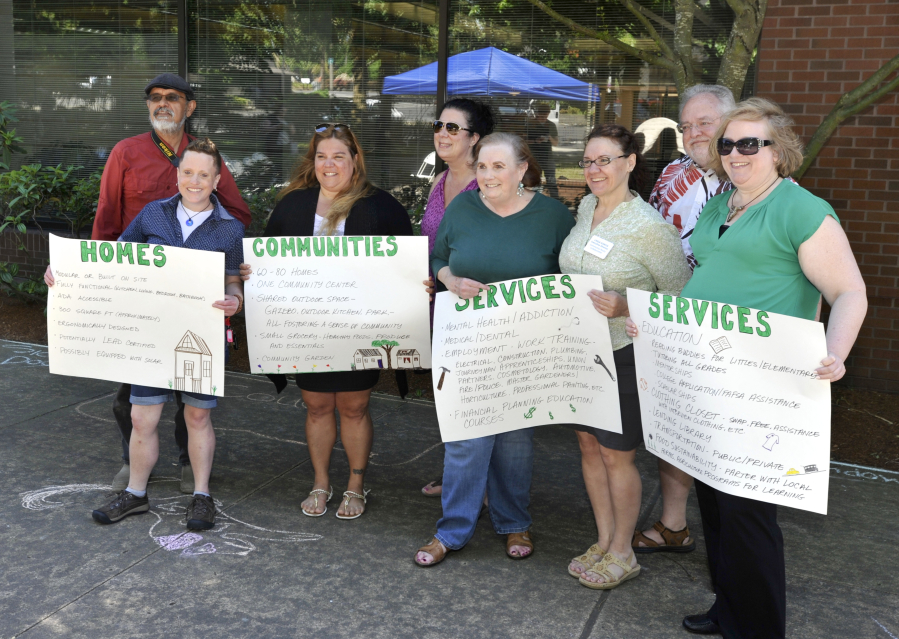Hector Hinojosa’s parents built their first home as a family. Same with their last home.
“It was a cooperative effort of family and friends. The old idea of, you get your neighbors together and you build a home,” he told the crowd gathered at the sculpture garden at Broadway and 9th Street Sunday.
That, he said, was the genesis for the idea of the Community Roots Collaborative: A new effort, announced that afternoon, to build 200 tiny homes in an effort to help the unhoused in Clark County escape chronic homelessness and find a place in the community.
Hinojosa organized the Stone Soup Community Meals program, which has provided all guests a meal at the sculpture garden every month for the past three years. The collaborative, in part, came from that, he said.
The collaborative hopes to build blended communities, he said, where half of the residents are moving into permanent housing, while the other half are people just looking to rent a small home, with expenses and mortgages set based on need.
“The idea is to make it sustainable,” said Hinojosa, who’s the collaborative’s president.
The collaborative would own the land, he said, and the residents the house. That model takes some of the cost and tax burden off the resident.
“The idea is to build equity, so you become the owner of that home,” he said. “So you hopefully take care of it, because it’s yours, and you get a little bit of dignity that goes with that. You’re a homeowner.”
Linda Garcia, the group’s executive director, said the collaborative will have first go at buying back the homes should someone want to move.
“They stay as long as they want, or they can use it kind of as a stepping stone, if that’s the sense that they get, or if that’s what they need,” she said.
Garcia said she knows of tiny home clusters housing at-risk women or veterans, but the collaborative’s plans are different in that it’s trying to build a blended community.
Beyond helping with economic viability, she said, having that mix of people can provide support for those dealing with housing insecurity, and who are trying to create some stability in their lives.
The group’s nonprofit paperwork is not yet finished, Garcia said, but it intends to start looking for grants and raising money.
At the moment, the group’s plans call for 200 homes in 5-acre lot “villages” of 60 to 80 300-square-foot homes, she said, with a rough budget of $10 million for the entire project.
Of that, she said, $8 million would go to home costs and the rest to staff and services costs.
“One of the biggest parts of our tiny home neighborhoods is going to be the services we provide,” she said.
The group, with the help of public agencies and private organizations, wants to provide access to mental health and addiction services at each village, along with assistance with health and dental care, employment training, financial literacy training, education services and a clothing closet and lending library.
As far as the houses themselves, the tentative plans would have the homes built around a communal area, with a gazebo or outdoor kitchen.
The idea there is to further reinforce the group’s goal to give residents a feeling of community, Garcia said.
She said the group also wants each village to have a small grocery, where healthy, fresh food is available, possibly through some kind of community-supported agriculture model.
There are also plans to make the homes green-building certified, and, since they’re so small, include a solar panel on the roof to provide power.
Garcia said the collaborative hopes to build its villages within Vancouver to be closer to services.
Vancouver Councilor Anne McEnerny-Ogle, who spoke at the gathering, said the city would have to update its accessory dwelling unit codes to allow for financing and for building tiny homes.
“What we need is housing, and that’s the big push we’re going for,” she said.
According to the most recent single-day census of the county’s homeless population, taken Jan. 26, the number of homeless people grew by more than 8 percent this year. Case workers and volunteers with the annual Point in Time tally counted 749 people, including 234 children, living in shelters or outside.
Garcia said the group’s “dream goal” is to have the first village set up by winter, so the area doesn’t see the same crunch of beds and shelter space as it did through last winter’s cold snap.
“Vancouver needs this. This is kind of the next step,” she said. “It’s the step beyond temporary shelter.”




